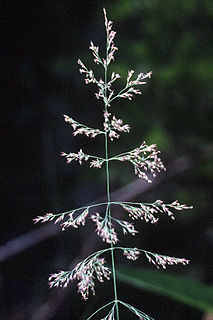
Abutilon is a large genus of flowering plants in the mallow family, Malvaceae. It is distributed throughout the tropics and subtropics of the Americas, Africa, Asia, and Australia. General common names include Indian mallow and velvetleaf; ornamental varieties may be known as room maple, parlor maple, or flowering maple. The genus name is an 18th-century New Latin word that came from the Arabic ’abū-ṭīlūn, the name given by Avicenna to this or a similar genus.

Dioscorea is a genus of over 600 species of flowering plants in the family Dioscoreaceae, native throughout the tropical and warm temperate regions of the world. The vast majority of the species are tropical, with only a few species extending into temperate climates. It is named by the monk Charles Plumier after the ancient Greek physician and botanist Dioscorides.

Calamagrostis is a genus of flowering plants in the grass family Poaceae, with about 260 species that occur mainly in temperate regions of the globe. Towards equatorial latitudes, species of Calamagrostis generally occur at higher elevations. These tufted perennials usually have hairless narrow leaves. The ligules are usually blunt. The inflorescence forms a panicle. Some may be reed-like.

Conyza is a genus of flowering plants in the sunflower family.

Azorella is a genus of flowering plants in the family Apiaceae, native to South America, New Zealand, southeastern Australia, and the islands of the Southern Ocean.

Calceolaria, also called lady's purse, slipper flower and pocketbook flower, or slipperwort, is a genus of plants in the family Calceolariaceae, sometimes classified in Scrophulariaceae by some authors. This genus consists of about 388 species of shrubs, lianas and herbs, and the geographical range extends from Patagonia to central Mexico, with its distribution centre in Andean region. Calceolaria species have usually yellow or orange flowers, which can have red or purple spots. The Calceolaria Herbeohybrida group, also called C. herbeohybrida Voss, is a group of ornamental hybrids known only in cultivation, called florists slipperwort.

Erythroxylum (Erythroxylon) is a genus of tropical flowering plants in the family Erythroxylaceae. Many of the approximately 200 species contain the drug cocaine; Erythroxylum coca, a native of South America, is the main commercial source of cocaine and of the mild stimulant coca tea. Another species, Erythroxylum vaccinifolium is used as an aphrodisiac in Brazilian drinks and herbal medicine.

Aechmea is a genus of flowering plants in the family Bromeliaceae. The name comes from the Greek aichme, meaning "spear". Aechmea comprises eight subgenera and around 250 species distributed from Mexico through South America and the Caribbean. Most of the species in this genus are epiphytes.

Melhania is a genus of small shrubs or herbaceous plants. Traditionally included in the family Sterculiaceae, it is included in the expanded Malvaceae in the APG and most subsequent systematics. The genus is named for Mount Melhan in Yemen.

Viguiera is a genus of flowering plants in the sunflower family, Asteraceae. The name honours French physician L. G. Alexandre Viguier (1790–1867). It contains around 150 species, which are commonly known as goldeneyes and are native to the New World. These are herbs to bushy shrubs that bear yellow or orange daisy-like flowers.

Melica is a genus of perennial grasses known generally as melic or melic grass. They are found in most temperate regions of the world.

Hibisceae is a tribe of flowering plants in the mallow family Malvaceae, subfamily Malvoideae.

Jacquemontia is a genus of plants in the morning glory family Convolvulaceae. Species in this genus are commonly known as clustervine.

Tetrapterys is a genus of flowering plants in the family Malpighiaceae, native to Latin America and the Caribbean, from Mexico through to Argentina, but excluding Chile. Small trees, shrubs or vines, they are known to be toxic to livestock if consumed for long periods of time, and T. mucronata and T. styloptera have hallucinogenic effects in humans similar to ayahuasca.

Corynabutilon is a genus of flowering plants in the family Malvaceae, native to southern Chile and Argentina. They are shrubs or small trees.

Acaulimalva is a genus of plants in the family Malvaceae. It contains 21 species that are found in South America.
Andeimalva is a genus of flowering plants belonging to the family Malvaceae.















